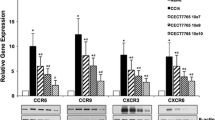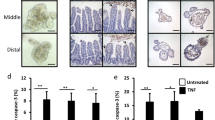Abstract
Background
Although bacterial translocation is a significant problem in patients with obstructive jaundice, how translocation is promoted in this situation is not clearly understood. We previously reported the recovery of gut mucosal T-lymphocyte numbers in jaundiced rats following internal biliary drainage. This suggests that bile in the intestinal lumen promotes T-lymphocyte redistribution into the gut mucosa. To test this hypothesis, we have examined the expression patterns of chemokines that play an important role in lymphocyte recruitment into the small intestine.
Methods
Four groups of rats receiving one of the following surgical procedures were studied: a sham operation (SHAM), common bile duct ligation (CBDL), CBDL followed by external drainage, or CBDL followed by internal drainage. Expression levels of intestinal mRNAs encoding TECK, MECK, and LARC chemokines were assessed using real-time polymerase chain reaction. Distribution of chemokine mRNA in the rat ileum was examined using in situ hybridization (ISH).
Results
Following surgery, the expression levels of TECK mRNA decreased significantly in the CBDL group compared with in the SHAM group. While TECK expression did not recover after external drainage, it recovered to a near-normal level after internal drainage. Expression levels of MECK and LARC mRNAs were similar among all groups. ISH confirmed strong expression of TECK mRNA in the epithelial cells of the small intestine.
Conclusions
These results indicate that bile may contribute to high expression levels of TECK/CCL25 mRNA in the small intestine. Bile may also have a role in regulating the distribution of gut mucosal T lymphocytes by promoting TECK production from epithelial cells.
Similar content being viewed by others
References
Assimakopoulos SF, Vagianos CE, Charonis A, Nikolopoulou VN, Scopa CD. Intestinal failure in obstructive jaundice. World J Gastroenterol 2005;11:3806–3807.
Deitch EA, Sittig K, Li M, Berg R, Specian RD. Obstructive jaundice promotes bacterial translocation from the gut. Am J Surg 1990;159:79–84.
Clements WD, Parks R, Erwin P, Halliday MI, Barr J, Rowlands BJ. Role of the gut in the pathophysiology of extrahepatic biliary obstruction. Gut 1996;39:587–593.
Kamiya S, Nagino M, Kanazawa H, Komatsu S, Mayumi T, Nimura Y, et al. The value of bile replacement during external biliary drainage: an analysis of intestinal permeability, integrity, and microflora. Ann Surg 2004;239:510–517.
Assimakopoulos SF, Scopa CD, Zervoudakis G, Mylonas PG, Georgiou C, Nikolopoulou V, et al. Bombesin and neurotensin reduce endotoxemia, intestinal oxidative stress, and apoptosis in experimental obstructive jaundice. Ann Surg 2005;241:159–167.
Sano T, Ajiki T, Takeyama Y, Kuroda Y. Internal biliary drainage improves decreased number of gut mucosal T lymphocytes and MAdCAM-1 expression in jaundiced rats. Surgery 2004;136:693–699.
Fukuoka K, Ajiki T, Miyazawa M, Takeyama Y, Onoyama Y, Kuroda Y. Changes in the number of gut mucosal T-lymphocytes and macrophages in patients treated by external biliary drainage. Eur J Surg 2001;167:684–688.
Macpherson AJ, Martiniv MM, Harris N. The function of mucosal T cells in containing the indigenous commensals flora of the intestine. Cell Mol Life Sci 2002;59:2088–2096.
Gautreaux MD, Deitch EA, Berg RD. T lymphocytes in host defense against bacterial translocation from the gastrointestinal tract. Infect Immun 1994;62:2874–2884.
Zlotnik A, Yoshie O. Chemokines: a new classification system and their role in immunity. Immunity 2000;12:121–127.
Stain JV, Arrieta CN. Chemokine control of lymphocyte trafficking: a general overview. Immunol 2005;116:1–12.
Yoshie O, Nomiyama H, Imai T. Chemokines in immunity. Adv Immunol 2001;78:57–110.
Moser B, Wolf M, Walz A, Loetscher P. Chemokines: multiple levels of leukocyte migration control. Trends Immunol 2004;25:75–84.
Evert LM, Schaerli, P, Moser B. Chemokine-mediated control of T cell traffic in lymphoid and peripheral tissues. Mol Immunol 2005;42:799–809.
Papadakis KA, Prehn J, Nelson V, Cheng N, Binder SW, Targan SR, et al. The role of thymus-expressed chemokine and its receptor CCR9 on lymphocytes in the regional specialization of the mucosal immune system. J Immunol 2000;165:5069–5076.
Bowman EP, Kuklin NA, Youngman KR, Lazarus NH, Kunkel EJ, Butcher EC, et al. The intestinal chemokine Thymus-expressed chemokine (CCL25) attracts IgA antibody-secreting cells. J Exp Med 2002;195:269–275.
Tanaka Y, Imai T, Baba M, Ishikawa I, Uehira M, Yoshie O, et al. Selective expression of liver and activation-regulated chemokine (LARC) in intestinal epithelium in mice and humans. Eur J Immunol 1999;29:633–642.
Kunkel EJ, Kim CH, Lazarus NH, Vierra MA, Bowman EP, Butcher EC, et al. CCR10 expression is a common feature of circulating and mucosal epithelial tissue IgA Ab-secreting cells. J Clin Invest 2003;111:1001–1010.
Kunkel EJ, Butcher EC. Chemokines and the tissue-specific migration of lymphocytes. Immunity 2002;16:1–4.
Mizuguchi K, Ajiki T, Onoyama H, Tomita M, Kuroda Y. Short-term effects of external and internal biliary drainage on liver and cellular immunity in experimental obstructive jaundice. J Hepatobiliary Pancreat Surg 2004;11:176–180.
Livak KJ, Schmittgen TD. Analysis of relative gene expression data using real-time quantitative PCR and the 2(-Delta Delta C(T)) method. Methods 2001;25:402–408.
Braissant O, Wahli W. A simplified in situ hybridization protocol using non-radioactively labeled probes to detect abundant and rare mRNAs on tissue sections. Biochemica 1998;1:1–10.
Owens WE, Berg RE. Bacterial translocation from the gastrointestinal tract of athymic (nu/nu) mice. Infect Immun 1980;27:461–467.
Gautreaux MD, Gelder FB, Deitch EA, Berg RD. Adoptive transfer of T lymphocytes to T-cell-depleted mice inhibits Escherichia coli translocation from the gastrointestinal tract. Infect Immun 1995;63:3827–3834.
Campbell DJ, Butcher EC. Intestinal attraction: CCL25 functions in effector lymphocyte recruitment to the small intestine. J Clin Invest 2002;110:1079–1081.
Zabel BA, Agace WW, Campbell JJ, Heath HM, Parent D, Roberts AI, et al. Human G protein-coupled receptor GPR-9-6/CC chemokine receptor 9 is selectively expressed on intestinal homing T lymphocytes, mucosal lymphocytes, and thymocytes and is required for thymus-expressed chemokine-mediated chemotaxis. J Exp Med 1999;190:1241–1255.
Schutyser E, Struif S, Van Damme J. The CC chemokine CCL20 and its receptor CCR6. Cytokine Growth Factor Rev 2003;14:409–426.
Fujiie S, Hieshima K, Izawa D, Nakayama T, Oyanagi H, Yoshie O, et al. Proinflammatory cytokines induce liver and activation-regulated chemokine/macrophage inflammatory protein-3alpha/CCL20 in mucosal epithelial cells through NF-kappaB. Int Immunol 2001;13:1255–1263.
Iwasaki A, Kelsall BL. Localization of distinct Peyer’s patch dendritic cell subsets and their recruitment by chemokines macrophage inflammatory protein (MIP)-3α, MIP-3β, and secondary lymphoid organ chemokine. J Exp Med 2000;191:1381–1393.
Zhao X, Sato A, Dela Cruz CS, Linehan M, Luegering A, Kucharzik T, et al. CCL9 is secreted by the follicle-associated epithelium and recruit dome region Peyer’s patch CD11b+ dendritic cells. J Immunol 2003;171:2797–2803.
Hieshima K, Kawasaki Y, Hanamoto H, Nakayama T, Nagakubo D, Yoshie O, et al. CC chemokine ligands 25 and 28 play essential roles in intestinal extravasation of IgA antibody-secreting cells. J Immunol 2004;173:3668–3675.
Ngo VN, Korner H, Gunn MD, Schmidt KN, Riminton DS, Cooper MD, et al. Lymphotoxin α/β and tumor necrosis factor are required for stromal cell expression of homing chemokines in B and T cell areas of the spleen. J Exp Med 1999;189:403–412.
Kang HS, Chin RK, Wang Y, Yu P, Wang J, Newell KA, et al. Signaling via LtβR on the lamina propria stromal cells of the gut is required for IgA production. Nat Immunol 2002;3:576–582.
O’Gorman MT, Jatoi NA, Lane SJ, Mahon BP. IL-1beta and TNF-alpha induce increased expression of CCL28 by airway epithelial cells via an NfkappaB-dependent pathway. Cell Immunol 2005;238:87–96.
Ericsson A, Kotarsky K, Svensson M, Sigvardsson M, Agace W. Functional characterization of the CCL25 promoter in small intestinal epithelial cells suggests a regulatory role for caudal-related homeobox (Cdx) transcription factors. J Immunol 2006;176:3642–3651.
Hosoe N, Miura S, Watanabe C, Tsuzuki Y, Hokari R, Oyama T, et al. Demonstration of functional role of TECK/CCL25 in T lymphocyte-endothelium interaction in inflamed and uninflamed intestinal mucosa. Am J Physiol Gastrointest Liver Physiol 2004;286:G458–G466.
Hamilton LJ, Dai Y, Jackson GDF. Bile regulates the expression of major histocompatibility complex class II molecules on rat intestinal epithelium. Gastroenterology 1997;113:1901–1905.
Meurens F, Berri M, Siggers RH, Willing BP, Salmon H, Gerdts V, et al. Commensal bacteria and expression of two major intestinal chemokine, TECK/CCL25 and MEC/CCL28, and their receptors. PLoS ONE 2007;2:e677.
Author information
Authors and Affiliations
Rights and permissions
About this article
Cite this article
Matsumoto, T., Ajiki, T., Kajiwara, E. et al. Decreased expression of intestinal chemokine TECK/CCL25 in experimental obstructive jaundice and its reversal following internal biliary drainage. J Gastroenterol 43, 390–396 (2008). https://doi.org/10.1007/s00535-008-2173-x
Received:
Accepted:
Published:
Issue Date:
DOI: https://doi.org/10.1007/s00535-008-2173-x




